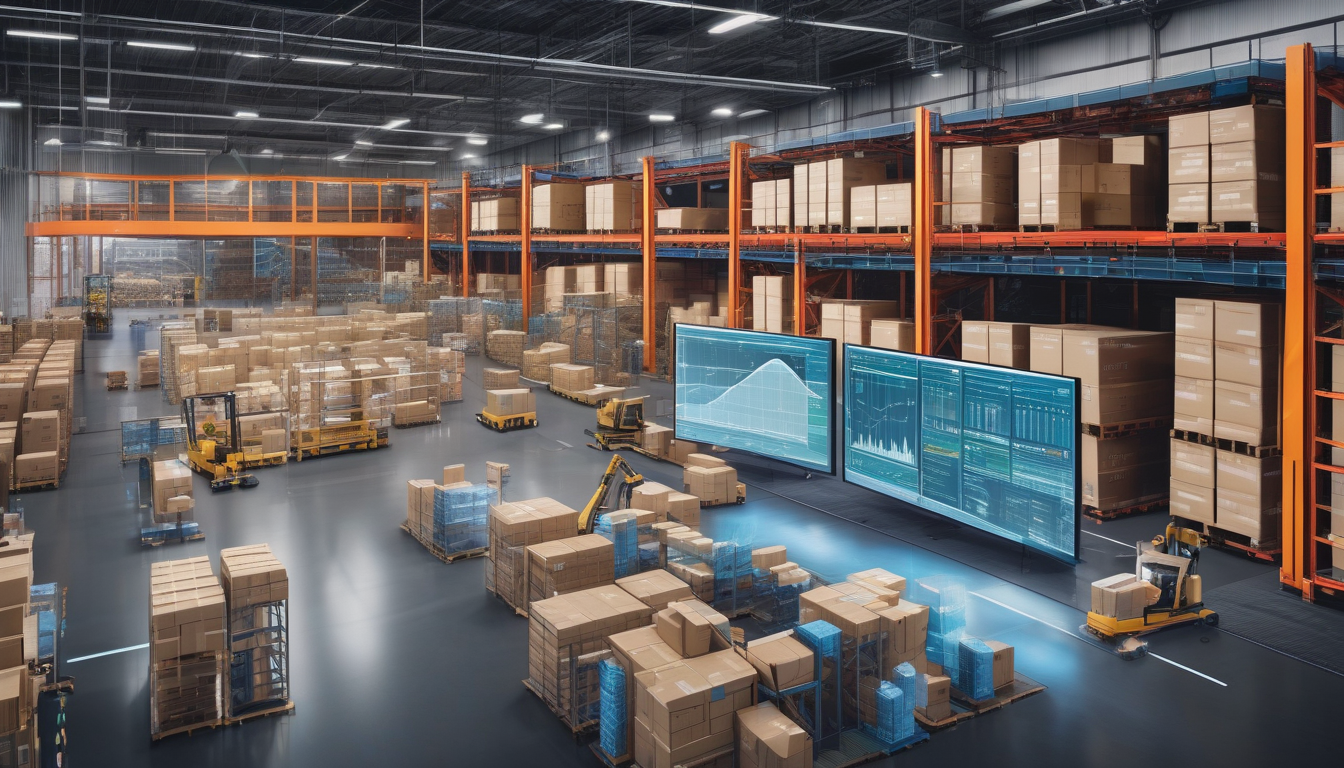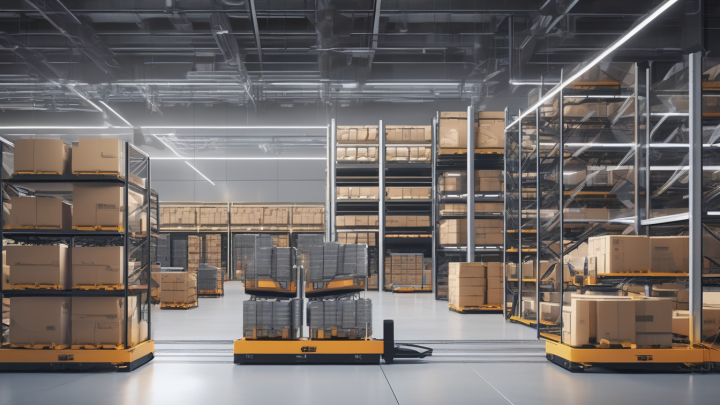In today’s fast-paced business environment, the importance of transparency in supply chain management cannot be overstated. With consumers demanding more accountability and companies striving for efficiency, artificial intelligence (AI) emerges as a game-changer. AI not only streamlines operations but also provides a clear view of every link in the supply chain, making it easier for organizations to identify bottlenecks and improve overall performance.
Imagine navigating a maze without a map—frustrating, right? That’s how many companies feel when they lack visibility into their supply chains. AI acts as that map, illuminating the path and revealing hidden challenges. By leveraging advanced algorithms, businesses can gain insights into their operations, allowing for better decision-making and enhanced agility.
Moreover, AI technologies such as machine learning and blockchain are pivotal in driving transparency. Machine learning analyzes vast datasets to uncover patterns, helping businesses predict trends and optimize processes. Meanwhile, blockchain offers a secure and immutable record of transactions, ensuring that every product’s journey is traceable and accountable. This dual approach not only enhances data accuracy but also fosters trust among stakeholders.
As we delve deeper into the world of AI in supply chains, it becomes clear that the benefits are profound. Companies that embrace these technologies can expect not only improved operational efficiency but also a stronger reputation among customers and partners. In a world where trust is paramount, AI-powered transparency could very well be the key to unlocking lasting success.

Understanding Supply Chain Transparency
Supply chain transparency is more than just a buzzword; it’s a critical element that can make or break a business. In today’s fast-paced market, where consumers demand to know the origins of their products, visibility into all processes and transactions within the supply chain is essential. Think of it like a glass house—when everything is visible, it fosters trust and accountability among all parties involved. But achieving this level of transparency is no walk in the park!
Companies face numerous challenges in their quest for transparency. For starters, the complexity of supply chains can be overwhelming. With multiple suppliers, manufacturers, and logistics providers, keeping track of every movement can feel like trying to find a needle in a haystack. Additionally, traditional systems often lack the necessary integration, making it difficult to share information across various platforms. This leads to data silos, where information is trapped in isolated systems, hindering effective decision-making.
Moreover, the importance of supply chain transparency cannot be overstated. It plays a pivotal role in risk management, allowing companies to quickly identify and address potential disruptions. When stakeholders have access to real-time data, they can make informed decisions that enhance overall efficiency. In a world where a single delay can ripple through the entire supply chain, having that transparency is akin to having a crystal ball that predicts issues before they arise.
In summary, achieving supply chain transparency is not just about compliance; it’s about building a resilient, efficient, and trustworthy operation. As businesses strive to meet consumer demands and regulatory requirements, embracing transparency will be key to staying ahead in the competitive landscape. So, how can companies overcome these challenges? The answer lies in leveraging advanced technologies, which we will explore in the next section.

AI Technologies Driving Transparency
In today’s fast-paced business world, artificial intelligence (AI) is emerging as a game-changer for supply chain transparency. It’s not just about having data; it’s about making that data work for you. AI technologies, including machine learning and blockchain, are at the forefront of this transformation, providing businesses with tools to enhance visibility and accountability across their supply chains.
Machine learning algorithms are particularly powerful. They can sift through mountains of data, identifying patterns that humans might overlook. For example, by analyzing historical sales data, these algorithms can predict future demand with remarkable accuracy. This predictive capability allows companies to adjust their inventory levels proactively, reducing the risk of overstocking or stockouts. Imagine being able to anticipate customer needs before they even express them; that’s the magic of machine learning!
Moreover, real-time monitoring is another area where AI shines. With advanced AI systems in place, businesses can receive timely alerts about potential disruptions in their supply chains. Whether it’s a delay in shipping or a sudden spike in demand, companies can respond swiftly, mitigating risks before they escalate. This level of responsiveness not only protects the bottom line but also enhances overall operational efficiency.
On the other hand, blockchain technology introduces a new dimension of transparency. By providing a decentralized ledger, blockchain enables all stakeholders in the supply chain to track products from origin to destination. This traceability is crucial for verifying the authenticity of goods and ensuring compliance with regulations. In an age where consumers are increasingly concerned about ethical sourcing, blockchain can be the key to building trust.
In summary, AI technologies are revolutionizing supply chain transparency by improving data accuracy and enabling real-time decision-making. By harnessing the power of machine learning and blockchain, businesses can not only enhance their operational efficiency but also foster stronger relationships with their stakeholders.
Machine Learning Applications
When we think about machine learning in the realm of supply chains, it’s like having a crystal ball that helps businesses foresee the future. These algorithms are not just crunching numbers; they are analyzing vast amounts of data to uncover patterns that humans might overlook. Imagine trying to find a needle in a haystack, but instead, you have a magnet that pulls the needle right to you. That’s the power of machine learning!
One of the most impressive applications of machine learning is in predictive analytics. By leveraging historical data, companies can forecast demand and supply trends with remarkable accuracy. This means they can anticipate what products will be hot sellers and which ones might gather dust on the shelves. For instance, if a retailer notices a spike in demand for winter jackets every October, they can adjust their inventory accordingly, preventing stockouts and reducing waste. This proactive approach not only saves money but also enhances customer satisfaction.
Another game-changer is real-time monitoring. Picture this: a company receives an alert about a potential disruption in their supply chain—maybe a delay in shipping or a sudden spike in demand. With AI systems in place, they can respond immediately, making adjustments to their logistics or production schedules. This level of responsiveness is crucial in today’s fast-paced market, where a delay could mean losing a customer to a competitor.
To sum it up, machine learning applications in supply chains are not just about efficiency; they are about creating a dynamic ecosystem that adapts to changes in real-time. By harnessing these advanced technologies, businesses can make informed decisions, optimize operations, and ultimately deliver better value to their customers.
Predictive Analytics in Supply Chains
Predictive analytics is revolutionizing the way companies manage their supply chains by utilizing historical data to forecast future trends. Imagine having a crystal ball that not only shows you what products will be in demand but also tells you when to stock them. This capability is not just a luxury; it’s becoming a necessity in today’s fast-paced market.
By employing sophisticated algorithms, predictive analytics can identify patterns in data that might go unnoticed by human analysts. For instance, if a company notices a consistent spike in demand for a particular product during holiday seasons, they can proactively adjust their inventory levels. This not only helps in maintaining optimal stock but also significantly reduces the chances of overstocking or stockouts, which can be detrimental to customer satisfaction.
Moreover, predictive analytics can enhance inventory management in several ways:
- Demand Forecasting: By analyzing past sales data, companies can predict future demand with remarkable accuracy.
- Supply Chain Optimization: It helps in determining the best times to reorder stock, minimizing holding costs.
- Waste Reduction: By aligning inventory levels with actual demand, businesses can significantly reduce waste, especially in perishable goods.
Additionally, the ability to forecast demand translates to better financial planning and resource allocation. Companies can allocate their budgets more effectively, ensuring that funds are directed towards areas that will yield the highest returns. This data-driven approach not only enhances operational efficiency but also empowers businesses to make informed decisions that align with market trends.
In summary, predictive analytics in supply chains is like having a roadmap that guides companies through the complexities of inventory management. By leveraging historical data, businesses can anticipate challenges, streamline their operations, and ultimately provide a better experience for their customers. As the market continues to evolve, those who harness the power of predictive analytics will undoubtedly stay one step ahead of the competition.
Real-time Monitoring and Alerts
In today’s fast-paced business environment, have become essential for maintaining a competitive edge in supply chain management. Imagine being able to spot a disruption before it escalates into a full-blown crisis—this is the power AI brings to the table. With advanced algorithms and data analytics, companies can track their supply chain processes in real-time, allowing for immediate responses to any irregularities.
AI systems continuously analyze data from various sources, such as IoT sensors and connected devices, to provide insights into the supply chain’s health. For instance, if a shipment is delayed due to unforeseen circumstances, the system can send instant alerts to the relevant stakeholders. This capability not only saves time but also mitigates risks associated with delays and disruptions.
Furthermore, the implementation of real-time alerts can significantly enhance decision-making. When the AI identifies a potential issue, it can provide actionable insights that prompt quick corrective measures. For example, if inventory levels drop below a certain threshold, an alert can trigger an automatic reorder, ensuring that stock levels are maintained without manual intervention.
To illustrate the impact of real-time monitoring, consider the following table that outlines key benefits:
| Benefit | Description |
|---|---|
| Proactive Risk Management | Identifies potential disruptions before they affect operations. |
| Improved Responsiveness | Enables quick adjustments to changing conditions. |
| Cost Savings | Reduces losses associated with delays and inefficiencies. |
In conclusion, the integration of real-time monitoring and alerts into supply chain operations not only fosters a culture of agility but also enhances overall efficiency. By leveraging AI technologies, businesses can ensure they are always a step ahead, ready to tackle challenges as they arise. This proactive approach is the key to thriving in the ever-evolving landscape of supply chain management.
Blockchain for Traceability
In today’s fast-paced world, traceability has become a critical aspect of supply chain management. Imagine being able to track a product from its origin to the final consumer with absolute certainty. This is where blockchain technology comes into play. By providing a decentralized and immutable ledger, blockchain ensures that every transaction is recorded and visible to all parties involved. This level of transparency is revolutionary, as it allows businesses to verify the authenticity of products and monitor their journey through the supply chain.
One of the standout features of blockchain is its ability to enhance accountability among stakeholders. With traditional systems, tracking a product’s history can be a cumbersome process, often filled with discrepancies. However, blockchain simplifies this by creating a single source of truth. Each participant in the supply chain can access real-time data, which significantly reduces the risk of fraud and errors. For instance, if a company needs to recall a product due to safety concerns, blockchain enables them to quickly identify the affected batches and notify customers without delay.
Moreover, the integration of blockchain with AI technologies amplifies its effectiveness. AI can analyze the vast amounts of data generated on the blockchain to provide actionable insights. This combination not only streamlines operations but also enhances decision-making processes. For example, companies can use AI to predict potential disruptions in the supply chain by analyzing historical blockchain data, thereby enabling proactive measures to mitigate risks.
To illustrate the impact of blockchain on traceability, consider the following table that highlights key advantages:
| Advantage | Description |
|---|---|
| Enhanced Visibility | Real-time tracking of products across the supply chain. |
| Increased Trust | Transparent transactions build confidence among stakeholders. |
| Improved Efficiency | Streamlined processes reduce time and costs associated with tracking. |
In conclusion, blockchain technology is not just a buzzword; it’s a game-changer for traceability in supply chains. By fostering transparency and accountability, it empowers businesses to build stronger relationships with their stakeholders while enhancing operational efficiency. As we continue to embrace these innovations, the future of supply chain management looks brighter than ever.

Benefits of Enhanced Transparency
In today’s fast-paced business environment, enhanced supply chain transparency is not just a buzzword; it’s a game-changer. Companies that embrace transparency can reap a multitude of benefits that not only streamline operations but also foster stronger relationships with stakeholders. Imagine a world where every transaction is visible, every product traceable, and every decision backed by real-time data. Sounds appealing, right? Let’s dive into some of the key advantages.
First and foremost, enhanced transparency builds trust among partners. When businesses operate openly, it cultivates a sense of reliability and integrity. Stakeholders, including customers and suppliers, feel more confident in their engagements. For instance, when a supplier knows they can trust a company to share accurate data regarding demand forecasts, it can lead to more efficient operations and better collaboration.
Moreover, transparency significantly boosts customer satisfaction. In an age where consumers are increasingly demanding, having the ability to provide them with real-time information about their orders and product origins can set a company apart from its competitors. Customers appreciate knowing where their products come from and how they are made, which can lead to increased loyalty and repeat business. Companies that leverage AI to offer insights into their supply chain can enhance the overall customer experience, making it more personalized and engaging.
Another crucial benefit is the reduction of operational risks. With real-time data and monitoring, companies can swiftly identify and address potential disruptions before they escalate. For example, if an AI system detects a delay in shipping, it can alert the relevant parties immediately, allowing for proactive measures to be taken. This kind of responsiveness not only mitigates risks but also enhances overall operational efficiency.
In summary, the benefits of enhanced transparency in supply chains are profound. From building trust with stakeholders to improving customer experiences and reducing risks, the advantages are clear. As businesses continue to navigate the complexities of modern supply chains, embracing transparency powered by AI technologies will be key to success.
Building Trust with Stakeholders
In today’s fast-paced business environment, trust is more than just a buzzword—it’s a critical currency. When it comes to supply chains, building trust with stakeholders is essential for fostering strong relationships and ensuring smooth operations. But how can companies achieve this? The answer lies in enhanced transparency facilitated by artificial intelligence (AI).
AI technologies provide businesses with the tools to share information openly and accurately. By utilizing AI-driven insights, companies can offer stakeholders real-time data on inventory levels, shipment statuses, and potential disruptions. This level of visibility not only keeps everyone informed but also empowers partners to make informed decisions. Imagine a scenario where a supplier receives immediate alerts about a delay; they can adjust their operations to accommodate the change, minimizing impact.
Furthermore, the integration of machine learning and predictive analytics allows businesses to anticipate issues before they escalate. For example, if a particular product line is forecasted to experience a surge in demand, stakeholders can prepare in advance, ensuring that supply meets customer expectations. This proactive approach is crucial in building trust, as it demonstrates a commitment to collaboration and responsiveness.
To illustrate the impact of transparency on trust, consider the following:
| Aspect | Effect of Transparency |
|---|---|
| Communication | Open channels lead to better understanding and collaboration. |
| Accountability | Clear data sharing fosters a culture of responsibility. |
| Reliability | Timely updates enhance stakeholder confidence in operations. |
In essence, when companies leverage AI to provide transparency, they are not just sharing data; they are building a foundation of trust that can lead to long-lasting partnerships. The result? A resilient supply chain that can adapt and thrive, even in the face of challenges. So, why wait? Embrace the power of AI and watch your stakeholder relationships flourish!
Improving Customer Experience
In today’s fast-paced world, customer experience is everything. With the rise of e-commerce and online shopping, customers expect not just quality products but also seamless interactions. This is where artificial intelligence (AI) steps in to revolutionize the game. Imagine walking into a store where every item you touch knows your preferences—sounds futuristic, right? But AI is making this a reality.
AI enhances customer experience by analyzing data to provide personalized recommendations. For instance, when you browse an online store, AI algorithms track your behaviors, such as the items you view and the time you spend on each product. Using this data, AI can suggest products that align with your tastes, making your shopping experience not just easier but also more enjoyable. This tailored approach creates a sense of connection between the customer and the brand, which is invaluable.
Moreover, AI-driven chatbots are transforming customer service. These virtual assistants are available 24/7, providing instant responses to queries. Imagine having a personal shopper who never sleeps! Customers can ask questions, track orders, and resolve issues without waiting for a human representative. This level of accessibility and efficiency is crucial in retaining customers and boosting satisfaction.
Additionally, AI can help businesses anticipate customer needs through predictive analytics. By analyzing purchasing trends and behaviors, companies can stock up on popular items before demand spikes. This proactive approach not only minimizes wait times for customers but also enhances overall satisfaction. For example:
| Customer Need | AI Solution | Outcome |
|---|---|---|
| Quick responses to inquiries | AI chatbots | Increased customer satisfaction |
| Product recommendations | Personalized AI suggestions | Higher conversion rates |
| Stock availability | Predictive analytics | Reduced wait times |
In summary, AI is not just a tool; it’s a game-changer in enhancing customer experience. By leveraging AI technologies, businesses can build stronger relationships with their customers, ultimately leading to increased loyalty and satisfaction.
Frequently Asked Questions
- What is supply chain transparency?
Supply chain transparency refers to the visibility of all processes and transactions happening within the supply chain. It’s all about knowing what’s going on at every stage, from sourcing raw materials to delivering the final product. Think of it as having a clear window into the entire operation!
- How does AI enhance supply chain transparency?
AI enhances supply chain transparency by leveraging technologies like machine learning and blockchain. Machine learning analyzes data to spot patterns and predict trends, while blockchain provides an immutable record of transactions. Together, they create a more accurate and real-time view of supply chain activities, making everything more efficient.
- What are the benefits of increased supply chain transparency?
Increased supply chain transparency leads to numerous benefits, such as building trust with stakeholders, improving customer satisfaction, and reducing operational risks. When everyone can see what’s happening, it fosters better relationships and allows companies to respond more quickly to issues.
- Can predictive analytics really improve decision-making?
Absolutely! Predictive analytics uses historical data to forecast future trends, which helps companies make informed decisions. It’s like having a crystal ball that tells you what to expect, allowing for smarter inventory management and less waste.
- How does real-time monitoring work in supply chains?
Real-time monitoring uses AI systems to track supply chain activities continuously. When a disruption occurs, these systems send alerts immediately, enabling companies to react quickly and minimize risks. It’s like having a personal assistant that keeps an eye on everything for you!



